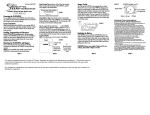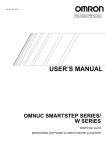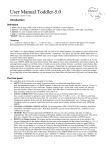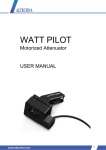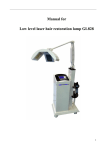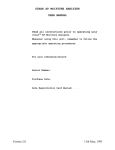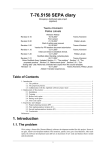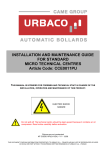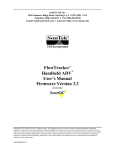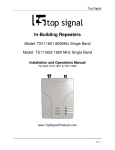Download EGT-Gauge USER MANUAL (FI)
Transcript
PIILIx-Design USER MANUAL EGTx Battery Operated Exhaust Gas Thermometer © 2015 PIILIx Design Table Of Contents 1. TECHNICAL DETAILS 3 1.1 General info�������������������������������������������������������������������������������� 3 1.2 Technical parameters����������������������������������������������������������������� 3 2.ASSEMBLY 4 2.1 Sensor assembly�������������������������������������������������������������������������� 4 2.2 Gauge assembly�������������������������������������������������������������������������� 4 3. USER MANUAL 5 3.1 ON-OFF operations������������������������������������������������������������������� 5 3.2 Reading and zeroing peak value����������������������������������������������� 5 3.3 Adjustment of the warning light���������������������������������������������� 5 3.4 Using of backlight����������������������������������������������������������������������� 5 3.5 Changing the battery����������������������������������������������������������������� 6 3.6Cleaning��������������������������������������������������������������������������������������� 7 3.7 Zero point calibration���������������������������������������������������������������� 7 3.8 WARNING AND WARRANTY���������������������������������������������� 7 Revision: A Date: 13.09.2015 Written: Veli-Pekka Vuoristo © PIILIx Design 2015 2 1. TECHNICAL DETAILS 1.1 General info EGTx is a one channel battery powered microcontroller based exhaust gas thermometer. It is designed for use with any K-type thermocouple sensor. Picture-1 EGTx Exhaust Gas Thermometer 1.2 Technical parameters SENSOR (not included in all sales packages): Type of sensor: K-type Type of tip:Insulated Material of sensor body: Inconel 600 Temperature range of sensor: -50-+1100°C Temperature range of sensor cable: -50-+700°C Temperature range of sensor connector: -50-+220°C GAUGE: Measurement range: 0-999°C Measurement resolution: ~4°C (8-bit) Measurement accuracy (0-999°C): ± 7°C Current consumption (no lights): 0.7mA Type of battery: CR2450N 3V Lithium Operation time without lights (25°C): approx. 800h Operation time with backlight ON (25°C): approx. 200h Operation time all lights ON (25°C): approx. 50h Operational temperature range: -10C-+60°C Protection class of the meter: IP55 (splash proof) Material of the case: Anodized aluminium Window material: 2mm acrylic plastic (hard coated) Cold point compensation operational range: -10-+60°C Accuracy of the cold point compensation: ± 5°C Dimensions, no cable (width x height x depth): 61 x 41 x 27 mm © PIILIx Design 2015 3 2. ASSEMBLY 2.1 Sensor assembly Sensor should preferably be assembled by TIG-welding (or by brazing in 2T engines) the weld-nut to the exhaust pipe. You must drill 6mm (1/4”) hole for sensor compression fixing kit to the exhaust pipe. Material of the weld-nut is stainless steel (AISI 304). The optimal place for the sensor in 2-stroke engine is something like 100-150mm from the piston edge. A good practice is to locate the sensor after the point where fresh inlet air oscillates during exhaust phase. This can be normally seen from the colour of the exhaust pipe inner surface. In 4-stroke engine suitable place for sensor is at the very beginning of the exhaust pipe. In turbocharged engine sensor can be located before or after the turbine. Sensor cable must be fixed with zip-ties etc in order to avoid vibration related problems. Constant bending must be avoided. To avoid electrical disturbances sensor cable must be located away from high current and high voltage cables like ignition and alternator cables. The woven protection layer of the sensor cable conducts electrical current. Please be careful when routing cable near battery or any other live circuits. This same shield may in some cases cause harmful ground loop currents. Sensor end of the shield is grounded to the sensor body. If shield is touching vehicles body then this shield is parallel connected to the engine grounding cable and it can conduct high currents especially when starting the engine. Rubber grommets and shrink tubes are good for insulation purposes. 2.2 Gauge assembly Gauge can be fixed to the wanted position by 2-sided tape or by supplied special fixing ‘3M Dual Lock™’ tape. To enable battery changing very rugged fixing is not preferred. If needed, small holes can be drilled to the back panel of the gauge. Please make sure not to short-circuit battery and also take care to retain enclosure sealing against water after modification. In high vibration use like in RR motorcycles it is a good practice to use foamy rubber or plastic for fixing. This will dampen the unwanted vibrations to acceptable level. © PIILIx Design 2015 4 3. USER MANUAL 3.1 ON-OFF operations Gauge can be switched on by shortly pressing upper button. As an indication for this a ‘888’ –will be shown shortly on display and immediately after that the gauge will show the current temperature of the sensor. Power can be switched OFF by pressing upper button for a couple of seconds, as soon as power is off the display will also be off. Under the same upper button there is additional operationality off backlight, more on chapter 3.4. Peak value and warning light value are in memory and wont disappear during power-OFF. Chancing battery, however resets these values and gauge needs reprogramming. 3.2 Reading and zeroing peak value When ON the gauge will save the highest peak value in its memory. Peak temp can be read from the memory by shortly pressing the lower button. If lower button is pressed for longer time, first 2 seconds there will be peak value on display. Then there is shown ‘0’ for indication of zeroing the peak value from the memory. Peak value will be kept in the memory even when the gauge is turned OFF. Battery changing resets this value. 3.3 Adjustment of the warning light Warning light adjustment can be done by the lower button. After a long pressing of the lower button described in the chapter 3.2 there will be a further warning light value showing and adjusting. If lower button is continuously pressed after peak value operations the gauge will show it’s current warning light limit. If still pressed the warning light value will scroll up with the steps of 5°C. If value is scrolled after 995°C, it will roll over and continue again from 0°C. When suitable value is displayed button pressing must be stopped and warning limit will be automatically saved to the value last seen on the display. After this the gauge will return to a normal operation within a couple of seconds. NOTE! Lower button has been designed to register one long pressing only. If lifted temporarily and then pressed again, the operation will not resume to the point where last operation happened. Warning light consumes a lot of current. To maximise battery life it is a good practice to adjust warning light to flash only when really necessary. 3.4 Using of backlight Backlight can be switched ON and OFF using upper button. When gauge is on, you can turn backlight ON and OFF by shortly pressing upper button. State of the backlight toggles with every short pressing of the button. After every pressing display shows the status of the backlight; ‘888’ = Backlight ON, ‘000’ = Backlight OFF. Default state of the backlight after turning the gauge on is OFF. After turning on the gauge display shows ‘888’, in this operational phase this means ‘Gauge ON’ not ‘Backlight ON’. Backlight consumes a lot of current. To maximise battery life use backlight sparingly. © PIILIx Design 2015 5 3.5 Changing the battery ‘Low battery’ warning is indicated by blinking the display. With this warning on you can still use the gauge but after some time the reliability of the measurement accuracy can be lost. Due to the battery chemistry this warning may sometimes come prematurely when gauge is used in extreme cold temperatures. After heating the gauge the operation will revert to a normal. Because of this known phenomena, it is advised to use back- and warning light sparingly in cold climates. Battery inside EGTx gauge is 3V lithium, type CR2450N. It is widely available from battery shops. Please note the lithium batteries are listed dangerous in air transportation. Because of these limits the manufacturer of this EGTx gauge (PIILIxDesign) cannot sell batteries other than the one supplied within the gauge. Battery is located behind the back panel, inside the gauge. To change battery you must remove back panel. To remove back panel unscrew all four Torx™ screws, size of the correct tool is T10. Back panel seal may be stick to the gauge frame but the panel can be easily removed by the help of chisel type screwdriver etc. Removing and reassembling the battery is best to proceed as seen on Pictures 1-2. When reassembling back panel, please make sure seal is correctly seated and do not overtighten the screws. Frame is made of aluminium and threads can’t stand extreme torquing the screws. Picture-2 Removing the battery Picture-3 Battery reassembly © PIILIx Design 2015 6 NOTE! WHEN CHANGING BATTERY, PLEASE TAKE CARE NOT TO TOUCH ANY INTERNAL CIRCUITS WITH THE BATTERY! RISK OF SHORT CIRCUITS AND TOTAL FAILURE OF THE GAUGE! Due to time in stock and the small data retention current consumption, the battery supplied with the gauge may have shorter than normal operational life. 3.6 Cleaning EGTx gauge frame and back panel is made of anodized aluminium and the front window is acrylic/polycarbonate plastic. Use only mild washing liquids for cleaning. Use of alkaline or heavy solvents may cause permanent damage to the surfaces of the EGTx gauge. Display window material is hard coated acrylic plastic with good resistance to scratching. It however has no glass-like surface and will be harmed if wiped with abrasive tools or cleaning fabrics. 3.7 Zero point calibration EGTx gauge has zero point/offset calibration trimmer, located near the battery. If for some reason the display value has drifted it can be readjusted back to accurate reading using this internal trimmer. A good method for recalibration is to use correct thermocouple calibrator but reasonable results can be achieved using for example boiling water (100°C at sea level). Please do not touch this trimmer if you are not familiar with thermocouple calibration. 3.8 WARNING AND WARRANTY EGTx gauge has one (1) year warranty, including racing use. Warranty time will be calculated from the day of purchase. Wire harness and sensor (if supplied) has no warranty because manufacturer have no way to know the correct assembly and operation of these. Failure in assembly and usage against sensible methods may remarkably shorten the useful life of these components. Clear material and manufacturing defects in the components are naturally included in the warranty. Failure of the sensor or gauge may cause severe problems if the display value of the EGTx gauge is the only method to analyse the behaviour of the engine. Manufacturer strongly suggest to use all other methods (spark plug colour, AFR-value etc) to evaluate the quality of ignition and fuel mapping before making any tuning based only on EGT values. Because the manufacturer of the EGTx gauge has no real method to affect the operations by the end user, all failures in engines etc are in no responsibility of the EGTx gauge manufacturer. EGTx gauge has no aviation authorities approvals. Use of EGTx in aeroplanes is in sole responsibility of the end user. © PIILIx Design 2015 7







